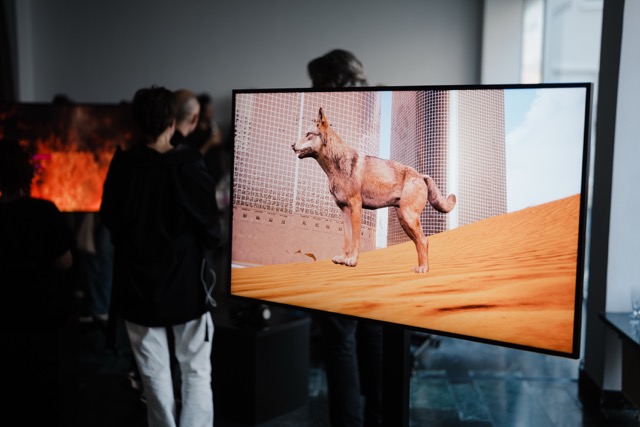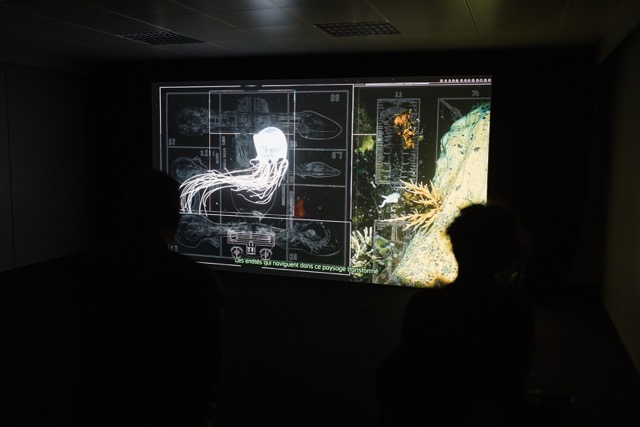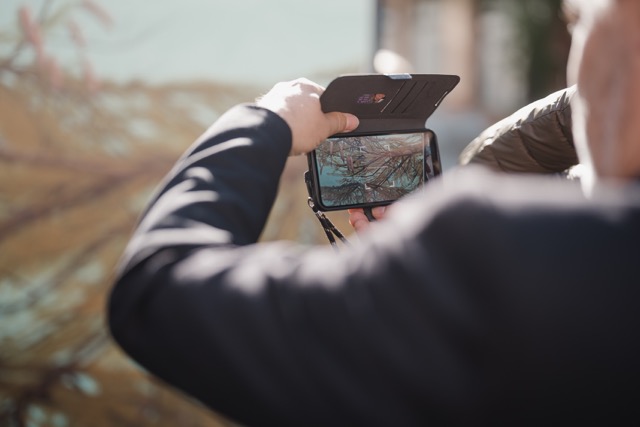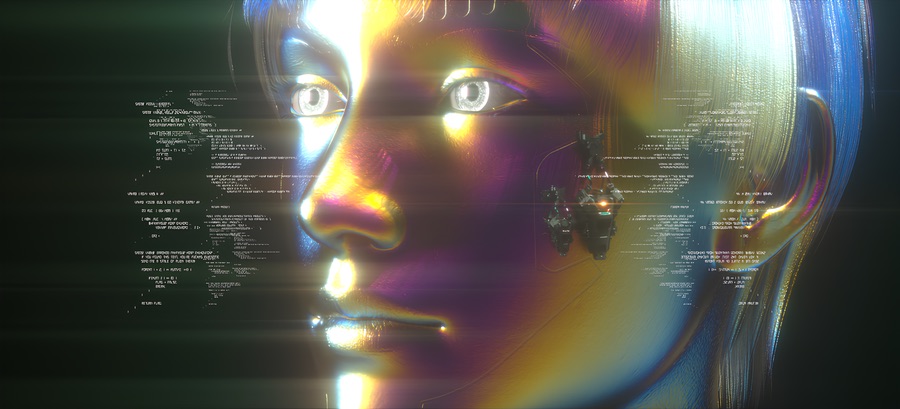An Exhibition Review by Maja Ćirić
A metamorphosis of intelligence is underway—not simply in how we think, but in how knowledge itself is organized, valued, and contested. It marks the erosion of inherited epistemologies and the emergence of new, hybrid ways of knowing. If shifts in intelligence parallel transformations in symbolic language, then exhibitions cease to be passive maps of change; they become active terrains where new modes of being and becoming are not only represented but rehearsed.

Exhibitions hold a unique power: to make visible the architectures of emergent worlds, to sketch the contours of collective possibility under unfamiliar skies, and—perhaps most critically—to illuminate the contradictions embedded in the very futures they help imagine. Exhibitions today are not passive detours into aesthetic contemplation, but laboratories for new political and ontological categories. Especially in an age of hybrid objects and conceptual blur, curated spaces invite audiences to decode the evolving mechanics of reality.
After all, it is art that helps us grasp the complexities and ambiguities of what Asma Mhalla calls “the technopolitics that stand in the shadow of the world’s chaos”(1). Across Europe, a growing constellation of institutions is working to spark meaningful dialogue about the challenges and opportunities of our digital age (2). Among them, Elektron in Luxembourg doesn’t just respond to the pulse of the present; it helps shape it. Through carefully attuned curation, it translates abstract symbolic systems into tactile, legible, and briefly inhabitable forms.
The new wave of new media art (3) — what I describe here as neosyntheticism—has taken shape amid the churn of the post-pandemic era. It’s less a movement than a scattered constellation of posthumanist, anti-authorial gestures—often dystopian, rarely utopian—that surface in art spaces to probe our place in a hyper-networked, sensor-overloaded world. Neosynthecism is not merely an art movement; it is a method, a worldview, a genre-defying field of creative inquiry. It marks the convergence of synthetic intelligence, ecological consciousness, and speculative worldbuilding.
Although sometimes interpreted through lenses ranging from techno-optimism to techno-fascism, the coordinates of this practice do not map onto any familiar terrain. Instead, they emerge within an expanded ideological landscape—elastic, unstable, and insistently hybrid.
Hybrid Futures: Rhizomes, Meshworks and Alter-Ecologies at Elektron in Esch-sur-Alzette (LU, 17 May–26 July 2025) curated by Françoise Poos and Vincent Crapon, renders this terrain with clarity and nuance. In the ambient haze of digital excess, art here functions less as a refuge than as a flashpoint—an anchor not of stability, but of orientation. Temporary. Tactical. Precisely where it needs to be.
Nestled inside a working-class shopping mall—right next to a spice shop, a hair salon and a shisha café where folks crowd around table games—Elektron refuses to hide behind the usual white walls. Its transparent facade breaks down the barrier between art and everyday life, making the exhibition less a place to look at and more a space to move through. Here, art doesn’t just sit pretty; it confronts you in the messy, noisy flow of public life. And in doing so, Elektron cracks open a rare space where humanism and posthumanism collide.
Neo Synthetic artists eschews material loyalty altogether, declaring themselves agnostic to medium. Yet in expanding their toolkits—embracing CGA (Computer Graphics and Animation), world-building engines, code, and algorithmic collaborators like MidJourney and other large language models—they’re not retreating from form but reconfiguring it.
These artists inhabit the space where tools become co-conspirators, channeling the poetics of systems in flux. Their work doesn’t merely depict a world in metamorphosis—it performs it. Through these elastic, evolving technologies, they engage with transformation as both method and message, crafting speculative aesthetics attuned to a reality that is less fixed, more programmable, and always on the verge of redefinition.
Within Hybrid Futures, subcategories of Neosynthecism unfold as fluid zones rather than fixed categories—each tracing a different synthesis of code, ecology, and speculation. Hybridity isn’t just aesthetic—it’s tactical. It’s how we unlearn binaries and undo the neat categories that have served power for too long. In a world flattened by planetary computation, where data extraction shapes the political and the social before we can speak, hybridity is a counter-move.
A way to fracture the algorithmic gaze, Algorithmic Animism surfaces in Sybil Montet’s video essay (4) Geomancy (5), which draws on ancestral knowledge and the divinatory art of geomancy, In this artwork where environmental data is rendered through AI into lush, ritualistic visual textures. Post-Anthroposcene Aestheticss runs through Alice Bucknell’s four-level video game The Alluvials and Joey Holder’s Abiogenesis (6), both rejecting human centrality in favor of speculative ecosystems and post-human evolution.

Abiogenesis is a profound exploration of alternative intelligences and the complexities of life, urging us to expand our understanding beyond conventional scientific frameworks. This isn’t just an aesthetic shift. It’s a call to rewire perception, to reroute flows of power, and to make space for other ways of knowing—and being.

Speculative Substrate emerges in CROSSLUCID’s Vaster than Empires (7), where surreal machinic worlds destabilize narrative structure itself. It is a generative AI film that reimagines Ursula K. Le Guin’s 1971 science fiction short story, Vaster than Empires and More Slow. In this work, CROSSLUCID assembled a bespoke AI system to interpret themes from Le Guin’s story, which centers on a planetary forest-mind that operates simultaneously at microscopic and global scales.

Bruce Eesly’s New Farmer (2023) is a provocative visual project that critiques the dominant narrative of the Green Revolution through a blend of historical mimicry, speculative fiction, and media deconstruction.

Presented as a series of 1960s-style documentary photographs, the work initially appears to celebrate genetic manipulation in agriculture—showcasing oversized vegetables and advanced farming techniques—but gradually shifts from plausible to absurd.
The AI-generated images reveal an alternative history where the Green Revolution leads not to monocultures, but to implausible abundance, exposing the seductive lies of both past propaganda and contemporary machine vision.
Technogaia takes form in Miguel Ângelo Marques’ Escola de Desenho Inconvencional, an audio interface that is both participatory and interactive, incorporating local plant life into its design.and in Tamiko Thiel & /p’s Waldwandel/Forest Flux, an AR installation where climate data becomes ghostly, tactile, and strangely beautiful — tracking tree decline and ecological flux through layered visual storytelling.

These works don’t just show change; they let you feel it. Neosyntheticism isn’t something you learn—it’s something you live. Strip it of experience, and it collapses into pure didacticism.
Across these coordinates, Neosynthesis isn’t a style. It’s a condition.
While poetic, ritualistic, or ambiguous approaches to tech art make it more difficult for capital to absorb, they are not immune to co-optation. By refusing clarity, utility, or linear meaning, these works disrupt the extractive logic of data and computation—they interfere with systems that rely on legibility and efficiency. Drawing from ancestral knowledge, speculative ritual, or non-Western epistemologies, such practices create friction within the algorithmic gaze. Yet capital is adaptive: it can aestheticize resistance, package ambiguity as innovation, and frame critique as content. What resists today may be branded tomorrow. The power of these works lies not in total immunity, but in how they delay, distort, or complicate commodification—offering temporary spaces where other ways of sensing, knowing, and valuing might emerge.
Hybrid Futures: Rhizomes, Meshworks, Alter-Ecologies
In an era increasingly governed by digital infrastructures and automated systems, the spatial, temporal, and relational coordinates that once structured human experience are being redefined. Power today is networked—distributed through code, platforms, supply chains, and predictive algorithms. Yet within this shifting terrain, new forms of vulnerability and control emerge. The exhibition Hybrid Futures: Rhizomes, Meshworks, Alter-Ecologies responds to these transformations, assembling digital artworks that probe the architectures of interdependence and trace the evolving contours of agency in synthetic environments.
“Rhizomes” reference systems that grow laterally, without hierarchy or fixed origin—suggesting decentralized strategies for resistance and regeneration. “Meshworks” point to forms of structure produced by accumulation, movement, and mutual entanglement. “Alter-ecologies” gesture toward the reconfiguration of social, technological, and biological systems—toward futures not yet fully captured by dominant paradigms. The works included here are not static representations; they are responsive environments, algorithmic agents, and hybrid systems operating across virtual and material domains.
Recent critical essays in contemporary art discourse—such as Kat Kitay’s “What Happened to Speculative Futurism?” (8) and Terry Nguyen’s “Hito Steyerl’s Medium Hot: The Age of Slop (9) —- have raised important concerns about the trajectory of digital art practices. Kitay critiques speculative futurism for its tendency toward polished but politically evasive aesthetics, arguing that it often reproduces escapist visions that obscure present realities. Nguyen, writing in response to Hito Steyerl’s recent book Medium Hot: Cooling Down Reality in a Time of Data Overload, interrogates the proliferation of AI-driven art and its reduction of creative labor to algorithmic pattern recognition. Both essays caution against a superficial embrace of technological aesthetics that fails to critically engage with the systemic conditions they emerge from.
To meaningfully engage with hybrid futures—those shaped by the accelerating convergence of digital systems, environmental urgencies, and shifting geopolitical paradigms—we must first understand the architectures we inhabit. This involves not only interrogating political economy, but also the affective and perceptual logics that frame our engagement with technology and governance. Before we assess what an image or system represents, we must examine how it captures us—how it persuades, conditions, and mediates our sense of agency and futurity.
The exhibition Hybrid Futures operates as a perceptual intervention. It does not ask only what emerging technologies do, but how they feel—how they shape relationality, temporality, and structures of governance. Importantly, the project situated itself not in the tradition of radical critique or dialectical confrontation, but within a liberal humanist and cautiously optimistic framework. Rather than dismantling existing structures, it aims to make them visible and negotiable, emphasizing the role of discernment, responsibility, and adaptive agency in shaping viable futures.
As Françoise Poos, artistic and scientific director of Elektron, notes, the imperative is to analyze not just the interconnections that define networked life, but their entailments—the latent consequences, dependencies, and ethical demands embedded within them. These systems—technological, ecological, and political—are not neutral. Participation requires attention, negotiation, and at times, principled resistance.
The works featured in Hybrid Futures expose underlying systems: those of control and extractivism, but also infrastructures of care and resilience. They speculate on which elements of our present may be carried forward, and which must be deliberately abandoned. Rather than proposing utopia, the exhibition outlines a dynamic and contested space of possibility—where aesthetics intersect with geopolitics, where the synthetic meets the ecological, and where data interfaces with lived experience.
Ultimately, the curatorial stance is not cynical, but strategic. It reflects a belief that in an era marked by systemic volatility and technological acceleration, critical engagement must be matched with imaginative foresight. By illuminating the perceptual and affective contours of emerging systems, Hybrid Futures contributes to a broader global dialogue on how we might shape, rather than merely endure, the futures to come.
On a more practical note, in the near future, Elektron—in collaboration with the Ministry of Culture and the CNA, Centre National de l’Audiovisuel — is committed to initiating a pioneering dialogue on the conservation of art based on large language models (LLMs). Together with two curators from Tate, this initiative aims to build expertise that does not yet exist: how to document, preserve, and understand artworks that integrate generative AI technologies.
The research will focus on the specific challenges of conserving LLM-driven practices and on developing methodologies for their archival documentation. At its core, the project envisions not only technical solutions, but also a cultural infrastructure that can ease the transition for artists working with these evolving tools—showing that sustainable preservation is both possible and essential for the future of digital art.
Reference notes:
1) Mhalla, Asma. Technopolitique: Comment la technologie fait de nous des soldats. Paris: Éditions de l’Observatoire, 2024.
2) (e.g. exhibitions like Echos of the past, promises of the future or Programmed Universes, MAC, Lyon, Other Intelligences, HEK, Basel, The World Through AI, Jeu de Paume, Paris etc).
3) The first wave of new media art emerged in the late 1980s to early 1990s, spurred by the rise of personal computing, digital networks, and early internet art; it built on earlier experiments in video, cybernetics, and interactive technologies from the 1960s and 1970s.
4) CGI animation, CGI physics simulation, poetry, live data, AI
5) Commissioned by a casual arts, Are You For Real.
6) Commissioned by Election and HEK Basel.
7) Commissioned by the Berggruen Institute for Future Humans.
8) Kat Kitay, “What Happened to Speculative Futurism?” ArtReview, June 6, 2025, https://artreview.com/what-happened-to-speculative-futurism-opinion-kat-kitay/. Nguyen, Terry. 2025.
9) “Hito Steyerl’s Medium Hot: The Age of Slop.” ArtReview, May 30, 2025. https://artreview.com/hito-steyerls-medium-hot-the-age-of-slop-artificial-intelligence-terry-nguyen-opinion/.
Author: Maja Ćirić, PhD – Independent curator and art critic. She has received the ISCP Curator Award, the Dedalus Foundation Curatorial Research Award, the Lazar Trifunović Award, the ArtsLink Independent Projects Award, and the Visual Artists Ireland Curatorial Research Award. Maja served as the curator of the Serbian Pavilion at the Venice Biennale in 2007 and as the commissioner in 2013. She also curated the BJCEM Mediterranea Young Artist Biennale in Tirana, Albania, in 2017, and the 20th Pančevo Art Biennale in Pančevo, Serbia, in 2022.
Featured Image: Sybil Montet Geomancy , 2024 Video essay – CGI







